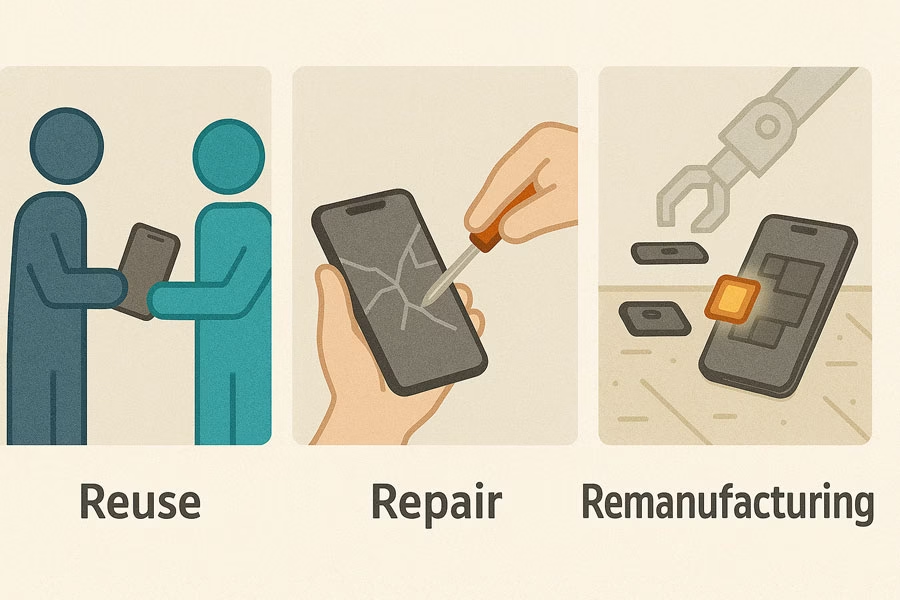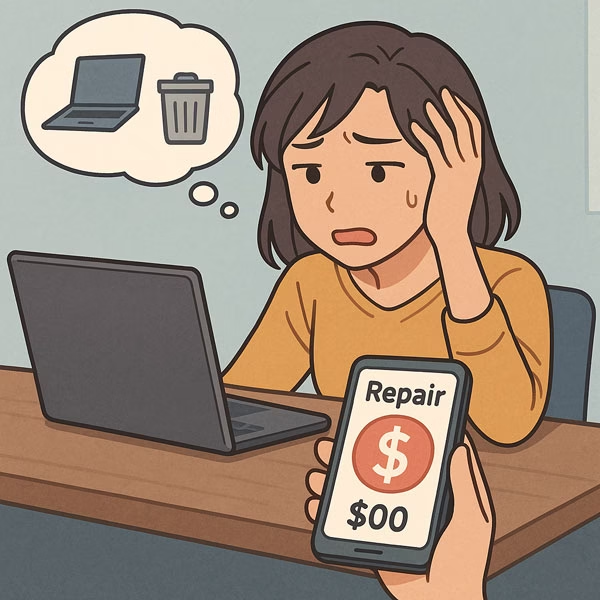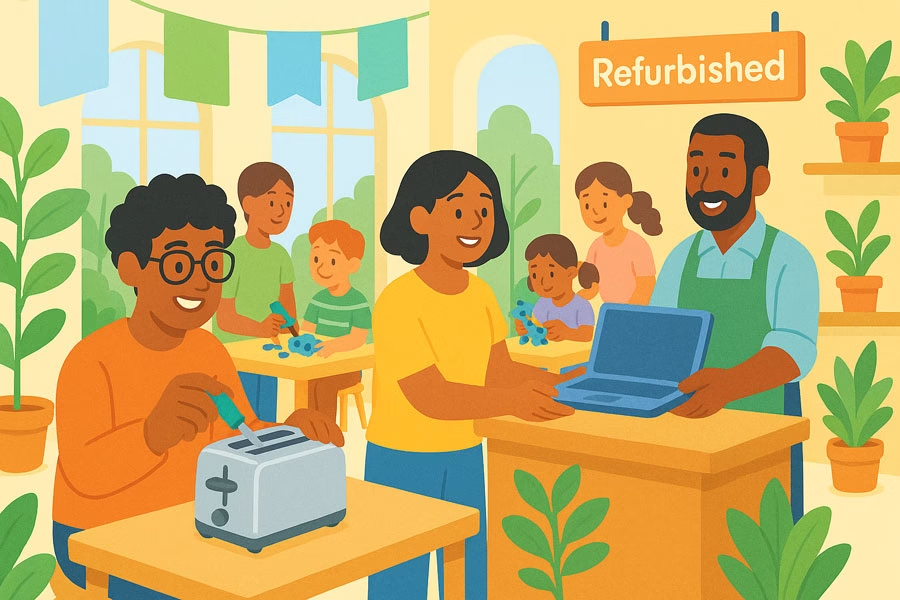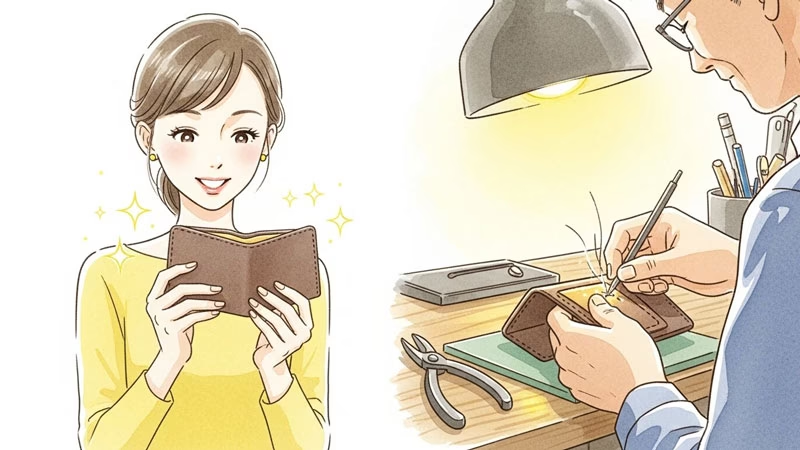突然ですが、あなたの周りを見渡してみてください。スマートフォン、パソコン、お気に入りの家電、毎日使う車…。私たちの暮らしは、本当にたくさんのモノで溢れていますよね。
でも、こんな経験ありませんか?
「スマホの画面が割れただけなのに、修理代が高すぎて結局新しいのを買っちゃった…」
「まだ使える家電だけど、新しいモデルが出たからなんとなく買い替えようかな…」
すごくよく分かります。新しい製品って魅力的ですし、なんだか気分も上がりますよね。
でも、少し立ち止まって考えてみてほしいんです。その「買い替え」、本当にもったいなくないですか?壊れたらすぐ捨てる、新しいものが出たらすぐ買う。そんな「大量生産・大量消費」のスタイルが、地球に大きな負担をかけているとしたら…。
実は今、世界中で「モノとの付き合い方」を見直す大きな動きが始まっています。そのキーワードが「サーキュラーエコノミー(循環型経済)」。そして、その実現のために欠かせないのが、今回ご紹介する「リマニファクチャリング」と「修理する権利」なんです。
なんだか難しそうな言葉に聞こえるかもしれませんが、心配しないでください。この記事を読み終わる頃には、きっと「なるほど!」「私もやってみよう!」と思えるはず。
これは、私たちの未来の暮らしを、もっと賢く、もっと豊かにするための大切なロードマップ。ぜひ最後までお付き合いくださいね。
はじめに:なぜ今、「修理して使い続ける」ことが重要なのか?
そもそも、なぜ今「修理して使い続ける」ことがこんなに注目されているのでしょうか。
それは、これまでの「作って、使って、捨てる」という一方通行の経済(リニアエコノミー)が、もう限界にきているからです。
地球の資源は無限ではありません。このままでは、資源が枯渇してしまうだけでなく、大量のゴミが地球環境を破壊してしまいます。
そこで登場したのが「サーキュラーエコノミー(循環型経済)」という考え方。これは、製品や資源をゴミとして捨てるのではなく、できるだけ長く使い、修理(リペア)したり、再利用(リユース)したり、そして新たな製品として生まれ変わらせる(リサイクル、リマニファクチャリング)ことで、資源をぐるぐると循環させていこうという新しい経済の仕組みなんです。
なんだか壮大な話に聞こえますが、これは私たちの暮らしと密接に関わっています。
- お気に入りの服を長く着るために、繕いをする。
- 読み終わった本を、古本屋さんやフリマアプリで次の人に譲る。
- 飲み終わったペットボトルを、きちんと分別してリサイクルに出す。
これらも、立派なサーキュラーエコノミーの一部なんですよ。
そして、この大きな循環の輪を力強く回していくために、今回主役となる「リマニファクチャリング」と「修理する権利」が、とても重要な役割を担っているんです。
次の章から、一つひとつ丁寧に解説していきますね。
第1章:リマニファクチャリングとは?リユースやリペアとの違いを解説

「リマニファクチャリング」、初めて聞いた方も多いかもしれませんね。カタカナでちょっと難しそうですが、実はとっても画期的で、私たちの未来に欠かせない技術なんです。
リマニファクチャリングの定義
リマニファクチャリングを日本語にすると「再製造」。言葉の通り、一度使われた製品を回収し、分解・洗浄・検査して、消耗した部品を交換・修理し、再び新品と同じレベルの品質を持つ製品として生まれ変わらせることを指します。
ここで大事なポイントは、「新品同等」というところ。
「それって、ただの中古品や修理品と何が違うの?」
そんな疑問が湧いてきますよね。その違いを、下の表で見てみましょう。
| 項目 | リマニファクチャリング | リペア(修理) | リユース(再利用) |
| 目的 | 新品同等の性能に復元 | 壊れた箇所を直す | そのままの状態で再び使う |
| プロセス | 分解、洗浄、部品交換、再組立、性能検査 | 故障箇所の特定、部品交換・補修 | 簡単な清掃、動作確認 |
| 品質 | 新品と同等 | 元の性能までは回復しないことも | 使用期間や状態により様々 |
| 保証 | 新品と同等の保証が付くことが多い | 修理箇所のみの限定的な保証 | 保証がない場合が多い |
| 見た目 | 新品と見分けがつかないことが多い | 使用感や傷が残ることがある | 使用感や傷がそのまま残る |

いかがでしょうか。
例えば、動かなくなった時計があったとします。
- リペアは、動かない原因である歯車だけを交換して、また時を刻めるようにすること。
- リユースは、まだ動くけれど使わなくなった時計を、そのまま他の人が使うこと。
- リマニファクチャリングは、時計をネジ一本まで完全に分解し、傷んだ部品はすべて交換し、ピカピカに磨き上げて、新品の時計と全く同じ品質検査に合格させてから、新品同様の保証を付けてお店に並べるイメージです。
つまり、リマニファクチャリングは、中古品とは一線を画す「製品の再生」なんです。
リマニファクチャリングのメリット・デメリット
このリマニファクチャリング、誰にとってどんな良いことがあるのでしょうか?企業、私たち消費者、そして社会全体の3つの視点からメリットをまとめてみました。
メリット
- 企業にとって
- 新品を製造するよりコストを抑えられる(資源・エネルギーが少なくて済む)
- 製品を回収することで、顧客との繋がりを長く保てる
- 回収した製品から、故障の原因や改善点などの貴重なデータを得られる
- 環境に配慮した企業として、イメージがアップする
- 「サービス」としての新しいビジネスチャンスが生まれる
- 私たち消費者にとって
- 新品と変わらない品質の製品を、より安価に購入できる
- 製品の選択肢が増える
- 環境に良い製品を選ぶことで、社会貢献につながる満足感を得られる
- 社会・環境にとって
- 廃棄物の量を大幅に削減できる
- 製品の製造に必要な資源やエネルギーを節約できる
- CO2排出量を削減し、地球温暖化の防止に貢献できる
特に、環境への貢献度は目を見張るものがあります。経済産業省の調査によると、製品によっては、新品の製造に比べてCO2排出量を80%以上も削減できるケースがあるそうです。すごい効果ですよね。
デメリット(課題)
もちろん、良いことばかりではありません。普及していくためには、いくつかの課題もクリアする必要があります。
- 回収した製品の状態がバラバラで、品質を均一に保つのが難しい
- 新品の販売数が減ってしまうのではないかという企業の懸念
- 製品を回収し、分解・再製造するための仕組み(物流や工場)を整える必要がある
- 消費者の「やっぱり新品が良い」という意識を変えていく必要がある
これらの課題を乗り越え、リマニファクチャリングが当たり前の選択肢になる社会を目指していくことが、今求められています。
第2章:「修理する権利」とは何か?私たちの生活にどう関わる?
リマニファクチャリングが企業側の大きな取り組みだとすれば、私たち消費者の側からこの流れを後押しするのが「修理する権利」という考え方です。

「修理する権利」の基本
「修理する権利(Right to Repair)」とは、その名の通り、私たちが購入した製品を、自分自身で、あるいは好きな修理業者に頼んで、自由に修理できる権利のことです。
「え、自分のものなんだから、修理するのは当たり前じゃない?」
そう思いますよね。でも、現実は少し違います。
皆さんも、こんな経験はありませんか?
- スマートフォンのバッテリーを交換したいだけなのに、メーカーの正規店に持ち込むしかなく、高額な費用がかかった。
- 家電が壊れたので近所の修理屋さんに見てもらおうとしたら、「メーカー専用の部品がないと直せない」と断られた。
- 製品の修理マニュアルが公開されておらず、どう直せばいいのか全く分からない。
このように、メーカー側が修理に必要な部品や道具、情報(マニュアルなど)を独占してしまい、消費者や独立した修理業者が簡単に修理できないようにしているケースが少なくありません。
「修理する権利」は、こうした状況に対して「おかしいんじゃない?」と声を上げ、メーカーに対して以下のことを求める運動なんです。
- 修理に必要な部品を、適正な価格で誰でも入手できるようにすること
- 修理の方法を記したマニュアルや、診断用のソフトウェアを公開すること
- 製品を設計する段階から、修理しやすいデザインにすること
つまり、「メーカーに修理を独占させないで!」という、私たち消費者のための権利なんですね。
なぜ「修理する権利」が注目されるのか?
この「修理する権利」を求める声が、世界中で急速に高まっています。その背景には、いくつかの深刻な問題があります。
1. 高すぎる修理費用と短い製品寿命
メーカーの正規修理は、手厚いサービスが受けられる一方で、どうしても費用が高くなりがちです。その結果、「修理代がこんなにかかるなら、新しいのを買った方がマシだ」と考えてしまう人が増えてしまいます。
また、メーカーによっては、数年経つとOSのアップデートが提供されなくなったり、修理サポートが打ち切られたりすることもありますよね。これは「計画的陳腐化」とも呼ばれ、意図的に製品の寿命を短くして、買い替えを促す戦略ではないかと批判されることもあります。
2. 増え続ける「電子ごみ」
修理されずに捨てられたスマートフォンやパソコン、家電などは、「電子ごみ(E-waste)」となって地球環境に重い負担をかけています。
国連の報告によると、2022年に世界で排出された電子ごみの量は、なんと6,200万トン。これは、大型トラック155万台分に相当する量だそうです。そして、そのうち適切にリサイクルされているのは、わずか22.3%に過ぎません。
電子ごみには、鉛や水銀などの有害物質が含まれている一方、金や銅などの貴重な資源も眠っています。修理して長く使うことは、この深刻な電子ごみ問題を解決する第一歩なんです。
3. 消費者の権利意識の変化
「自分の持ち物なのだから、どう扱うかは自分で決めたい」
「高価な製品を買ったのだから、できるだけ長く大切に使いたい」
サステナビリティ(持続可能性)への関心が高まる中で、モノとの付き合い方を見直し、消費者としての権利を主張する人が世界的に増えています。
「修理する権利」は、単に節約のためだけでなく、私たちの消費行動そのものを見つめ直し、より主体的で賢い消費者になるための、大切な権利だと言えるでしょう。

第3章:【国内外の動向】進む法制化と日本の現状
「修理する権利」を求める声は、単なる消費者運動にとどまらず、世界を動かす大きな力になっています。特に、環境意識の高いヨーロッパやアメリカでは、法制化の動きが活発です。
世界の動き:法制化で先行するEU・アメリカ
海外の先進的な取り組みを見てみましょう。
ヨーロッパ連合(EU)
EUは、この分野で世界をリードしています。
2024年4月、EU議会は消費者の「修理する権利」を強化する新たな指令案を圧倒的多数で可決しました。これは画期的な出来事です。
この法律の主なポイントは以下の通りです。
| EUの「修理する権利」のポイント | 具体的な内容 |
| メーカーの修理義務 | 保証期間が過ぎた後でも、スマートフォン、テレビ、洗濯機などの対象製品について、メーカーは修理に応じなければならない。 |
| 修理部品の提供 | メーカーは、独立した修理業者が利用できるよう、修理部品を適正な価格で提供しなければならない。 |
| 修理情報の公開 | 修理マニュアルなどの情報へのアクセスを保証する。 |
また、フランスでは2021年から、スマートフォンやノートパソコンなどの一部の電子機器に対して「修理可能性指数(Repairability Score)」の表示が義務付けられています。これは、製品がどれだけ修理しやすいかを10段階で評価し、消費者が購入時に参考にできるようにするものです。とても分かりやすい取り組みですよね。
アメリカ
アメリカでも、州レベルで法制化が進んでいます。
2023年にはニューヨーク州で「デジタル公正修理法」が施行されました。これは、デジタル電子機器のメーカーに対して、独立した修理業者や消費者に修理用の部品や情報を提供することを義務付けるものです。
その後、カリフォルニア州やミネソタ州など、他の州も次々と追随しています。特に、農業が盛んな州では、高価な農業機械の修理をメーカーに独占されることへの農家の不満が、法制化を後押ししたという背景もあるようです。
日本の現状と課題
では、私たちの国、日本ではどうでしょうか。
残念ながら、今のところ「修理する権利」を直接的に法制化しようという大きな動きは、欧米ほど活発ではありません。その背景には、日本特有の事情があると考えられます。
- 新品を好む市場性日本では、中古品よりも新品を好む傾向が根強くありますよね。「もったいない」という精神文化がある一方で、品質や衛生面へのこだわりから、やはりピカピカの新品を選びたいという気持ちが強いのかもしれません。
- メーカー主導の高品質なサポート体制日本のメーカーは、手厚いアフターサービスで知られています。何かあればメーカーに任せれば安心、という信頼感が、逆に「自分たちで修理する」という発想に繋がりにくかった面もあるでしょう。
- 安全・品質保証への懸念メーカー側からは、「資格のない業者が修理すると、安全性が損なわれたり、性能が劣化したりする恐れがある」という懸念の声も上がっています。特に、発火のリスクがあるバッテリーなどは、慎重な取り扱いが求められますからね。この点は、消費者としても理解できる部分です。
しかし、日本でも状況は少しずつ変わり始めています。消費者庁の検討会では、修理に関する課題が議論されていますし、サステナビリティへの関心の高まりとともに、世論も変化していく可能性があります。
海外の動きも参考にしながら、日本の文化や実情に合った形で、「修理して長く使う」ことが当たり前になる社会の仕組みづくりが、これからますます重要になってきますね。
第4章:企業の挑戦!リマニファクチャリングの先進事例
「修理する権利」の議論が進む一方で、課題を乗り越え、ビジネスチャンスとして「リマニファクチャリング」に積極的に取り組んでいる企業もたくさんあります。国内外の素敵な事例をいくつかご紹介しますね。
【建設機械】キャタピラー社(アメリカ)
リマニファクチャリングの草分け的存在といえば、アメリカの建設機械メーカー、キャタピラー社です。同社は、なんと1970年代からエンジン部品などの再製造に取り組んできました。
ユーザーから使い古した部品(コアと呼びます)を回収し、それを新品同様に再生して「Cat Reman」というブランドで販売しています。これにより、ユーザーはコストを抑えて機械を修理でき、キャタピラー社は資源を節約しながら収益を上げることができる。まさにWin-Winの関係ですよね。
このビジネスモデルは、建設機械のように高価で耐久性が求められる製品と、リマニファクチャリングの相性の良さを示しています。
【事務機器】キヤノン、富士フイルムビジネスイノベーション(日本)
実は、日本企業も負けていません。特に事務機器の分野では、世界をリードする取り組みが行われています。
- キヤノンキヤノンは、1992年から使用済みの複合機の回収と再製造に取り組んでいます。回収された製品は、厳しい基準のもとで分解・洗浄され、再び製品として生まれ変わります。その品質は新品と全く変わらないそうです。社内では、一度役目を終えた製品が美しく生まれ変わる姿から、このリマニファクチャリング複合機を「白鳥」と呼んでいるのだとか。なんだかロマンチックですよね。
- 富士フイルムビジネスイノベーション(旧:富士ゼロックス)こちらも、早くから資源循環に取り組んできた企業です。同社のコンセプトは「廃棄ゼロ」。使用済み商品を回収し、徹底的に再利用・再資源化します。リマニファクチャリングによって再生された部品は、新品の部品と同じ品質基準で管理され、再び製品に組み込まれます。
オフィスで何気なく使っている複合機が、実はこうした努力の結晶かもしれないと思うと、なんだか感慨深いものがありますね。
【自動車部品】
私たちの身近な自動車の世界でも、リマニファクチャリングは重要な役割を担っています。
エンジンやトランスミッション、オルタネーター(発電機)といった重要な部品は、故障した際に新品に交換すると非常に高価です。そこで活躍するのが「リビルドパーツ」。これは、まさにリマニファクチャリングされた部品のことです。
専門の業者が使い古しの部品を回収・分解し、消耗品を交換して、新品同様の性能に仕上げて販売しています。これにより、私たちは愛車をリーズナブルに修理し、長く乗り続けることができるのです。
これらの事例から分かるのは、リマニファクチャリングが単なる環境活動ではなく、顧客満足度を高め、新たな価値を生み出す「ビジネス戦略」として成り立っているということです。
第5章:持続可能な未来のために、私たちができること
ここまで、リマニファクチャリングと修理する権利について見てきました。
「なんだか大きな話で、自分にできることは少なそう…」
もしそう感じていたら、そんなことはありません。持続可能な未来に向けた変化は、私たち一人ひとりの小さな選択から生まれます。
最後に、消費者として、そしてビジネスに関わる一員として、今日からできることを一緒に考えてみましょう。
消費者としてできること
普段の買い物のとき、少しだけ視点を変えてみませんか?
1. モノを買うときのチェックリスト
新しい製品を選ぶとき、価格やデザイン、機能だけでなく、こんなポイントもチェックしてみてください。
- 修理はしやすい?
- バッテリーは自分で交換できるデザインか?
- 修理マニュアルは公開されているか?
- 特殊なネジが使われていて、簡単には開けられないようになっていないか?
- サポートは長い?
- メーカーの修理サポート期間はどれくらいか?
- 部品はいつまで供給される予定か?
- 選択肢はある?
- メーカーによるリマニファクチャリング品や、認定中古品は販売されているか?
すぐに全てを確認するのは難しいかもしれませんが、こうした意識を持つだけで、モノ選びの基準がきっと変わってきます。
2. 「捨てる」の前に考える
何かが壊れてしまったとき、すぐに「ゴミ箱行き」と決めつけないで。
- まずは修理を検討するメーカーの正規修理だけでなく、地域の修理店や、オンラインの修理サービス(iFixitなど)を調べてみましょう。意外と安く、簡単に直せるかもしれません。
- リマニファクチャリング品や中古品を探す買い替えるにしても、まずはリマニファクチャリング品や質の良い中古品がないか探してみる。フリマアプリやリサイクルショップも、宝探しのようで楽しいですよ。
企業としてできること
もしあなたがビジネスに関わっているなら、できることはさらに広がります。
- ライフサイクルを考えた製品設計(エコデザイン)「どう売るか」だけでなく、「使い終わった後どうなるか」までを考えて製品を設計することが重要です。修理しやすいデザイン、リサイクルしやすい素材選びなどが求められます。
- 情報の透明性を高める修理マニュアルや部品情報などを公開することで、顧客からの信頼が高まります。これは、長期的に見れば企業のブランド価値向上に繋がるはずです。
- 新しいビジネスモデルの模索単にモノを「売って終わり」にするのではなく、修理やメンテナンス、サブスクリプション(定額利用)といった「サービス」として提供することで、顧客と長く安定した関係を築くことができます。リマニファクチャリングは、その強力な武器になるでしょう。
まとめ

今回は、「リマニファクチャリング」と「修理する権利」という、未来の暮らしのキーワードについて、じっくりと掘り下げてみました。
- リマニファクチャリングは、使用済み製品を新品同様に蘇らせる「再製造」の技術。
- 修理する権利は、自分の持ち物を自由に修理し、長く使い続けるための消費者の権利。
この二つは、大量生産・大量消費の時代から、資源を大切に循環させる「サーキュラーエコノミー」へと移行していくための、車の両輪のような存在です。
もちろん、日本でこれが当たり前になるには、企業の努力、法律の整備、そして何より私たち消費者の意識の変化が必要です。
この記事を読んでくださったあなたが、次に何かを買うとき、あるいは何かが壊れたとき、「ちょっと待てよ」と立ち止まって、修理して使うこと、再生された製品を選ぶことを、選択肢の一つとして考えてくれたら、これ以上嬉しいことはありません。
お気に入りのモノを、賢く、お得に、そして愛情を持って長く使い続ける。そんな丁寧な暮らしが、私たち自身の生活を豊かにし、ひいては地球の未来をも明るく照らしてくれるはずです。
さあ、あなたも一緒に、新しいモノとの付き合い方を始めてみませんか?
Of course. Here is the English translation of the blog post.
Remanufacturing and the Right to Repair: Paving the Way for a Sustainable Future
Hello! I’m Emi, a web writer.
Let me ask you something. Take a look around you. Your smartphone, your computer, your favorite home appliances, the car you drive every day… Our lives are truly filled with so many things, aren’t they?
But have you ever had an experience like this?
“My phone screen just cracked, but the repair cost was so high that I ended up buying a new one…”
“This appliance still works, but a new model came out, so I feel like I should upgrade…”
I completely understand. New products are enticing, and they can really lift your spirits.
But I’d like you to pause and think for a moment. Is that “upgrade” truly necessary? Isn’t it a bit of a waste? What if this cycle of “buy, use, and toss” is placing a huge burden on our planet?
The truth is, a major movement to rethink our relationship with “things” is beginning all over the world. The keyword is “circular economy.” And to make it a reality, “remanufacturing” and the “right to repair,” which I’ll introduce today, are absolutely essential.
They might sound like complicated terms, but don’t worry. By the time you finish reading this article, I’m sure you’ll be thinking, “Oh, I get it!” and “I want to try that!”
This is an important roadmap to making our future lives smarter and richer. I hope you’ll stick with me to the end.
Introduction: Why is “Repairing and Continuing to Use” So Important Now?
First of all, why is the idea of “repairing and continuing to use” getting so much attention right now?
It’s because the one-way economy of “make, use, and dispose”—often called a linear economy—is reaching its limit.
The Earth’s resources are not infinite. If we continue on this path, we’ll not only deplete our resources but also destroy the global environment with massive amounts of waste.
This is where the concept of a “circular economy” comes in. It’s a new economic system that aims to circulate resources by using products for as long as possible, repairing them, reusing them, and eventually, transforming them into new products (through recycling and remanufacturing), rather than just throwing them away.
It might sound like a grand idea, but it’s closely connected to our daily lives.
- Mending your favorite clothes so you can wear them longer.
- Selling a book you’ve finished at a secondhand bookstore or through a flea market app.
- Properly sorting your empty plastic bottles for recycling.
These are all wonderful examples of the circular economy in action.
And to keep this great cycle turning strongly, our main topics today, “remanufacturing” and the “right to repair,” play a very important role.
Let’s dive into each one, step by step.
Chapter 1: What is Remanufacturing? Explaining the Difference from Reuse and Repair
“Remanufacturing.” You might be hearing this for the first time. It sounds a bit technical, but it’s actually a groundbreaking concept that’s indispensable for our future.
The Definition of Remanufacturing
Remanufacturing is the process of taking a used product, disassembling it, cleaning and inspecting it, replacing or repairing worn-out parts, and restoring it to a quality equivalent to a brand-new product.
The key point here is “equivalent to new.”
You might be wondering, “How is that different from a regular used or repaired item?” Let’s look at the differences in the chart below.
| Category | Remanufacturing | Repair | Reuse |
| Goal | Restore to like-new performance | Fix what’s broken | Use the item again as-is |
| Process | Disassembly, cleaning, part replacement, reassembly, performance testing | Identify fault, replace/fix parts | Light cleaning, operational check |
| Quality | Equivalent to new | May not fully restore original performance | Varies depending on age and condition |
| Warranty | Often comes with a like-new warranty | Limited warranty, often only for repaired parts | Often no warranty |
| Appearance | Often indistinguishable from new | May have signs of use or scratches | Signs of use and scratches remain |
What do you think?
For example, imagine a watch that has stopped working.
- Repair would be replacing just the gear that caused it to stop, so it can tell time again.
- Reuse would be someone else using the watch, which still works but is no longer wanted by the original owner.
- Remanufacturing is like completely disassembling the watch down to the last screw, replacing every worn part, polishing it to a brilliant shine, passing it through the exact same quality inspection as a new watch, and then selling it with a like-new warranty.
In other words, remanufacturing is the “rebirth” of a product, setting it apart from simply being “used.”
The Pros and Cons of Remanufacturing
So, who benefits from this, and how? Let’s look at the advantages from three perspectives: a business, us as consumers, and society as a whole.
Advantages
- For Businesses:
- Lower manufacturing costs (uses fewer resources and less energy).
- Maintains a long-term relationship with customers by collecting products.
- Gathers valuable data on failure points and potential improvements from collected products.
- Improves corporate image as an environmentally conscious company.
- Creates new business opportunities centered on “service.”
- For Us Consumers:
- Can purchase products of like-new quality at a lower price.
- Increases product choices.
- Provides a sense of satisfaction from contributing to society by choosing an eco-friendly product.
- For Society & the Environment:
- Significantly reduces the amount of waste.
- Conserves the resources and energy needed for manufacturing.
- Contributes to preventing global warming by reducing CO2 emissions.
The environmental contribution is particularly remarkable. According to a survey by Japan’s Ministry of Economy, Trade and Industry, some products can see CO2 emissions reduced by over 80% compared to manufacturing a new product. That’s an incredible effect, isn’t it?
Disadvantages (Challenges)
Of course, it’s not all upsides. For it to become widespread, several challenges need to be addressed.
- The condition of collected products varies, making it difficult to maintain uniform quality.
- Businesses worry that it might decrease sales of new products.
- Requires establishing a system (logistics and factories) to collect, disassemble, and remanufacture products.
- The consumer mindset of “new is always better” needs to evolve.
Overcoming these challenges and creating a society where remanufacturing is a common-sense choice is what’s needed now.
Chapter 2: What is the “Right to Repair”? How Does It Affect Our Lives?
If remanufacturing is a major initiative from the business side, the “right to repair” is the concept that empowers us, the consumers, to support this movement.
The Basics of the “Right to Repair”
The “Right to Repair” is, as the name suggests, the right of consumers to freely repair the products they own, either by themselves or by hiring a technician of their choice.
You might think, “It’s my property, so of course I can repair it, right?”
But in reality, it’s a bit more complicated.
Have you ever had one of these experiences?
- You just wanted to replace your smartphone battery, but your only option was to take it to the manufacturer’s official service center, which cost a fortune.
- Your home appliance broke, so you took it to a local repair shop, only to be told, “We can’t fix it without the manufacturer’s proprietary parts.”
- The product’s repair manual wasn’t public, so you had no idea how to even begin fixing it.
In many cases, manufacturers monopolize the parts, tools, and information (like manuals) necessary for repairs, making it difficult for consumers and independent repair shops to do the job.
The “right to repair” is a movement that says “This isn’t right!” and demands the following from manufacturers:
- Make necessary repair parts available to everyone at a fair price.
- Publish repair manuals and provide access to diagnostic software.
- Design products from the start to be easy to repair.
In short, it’s a right for us consumers that says, “Don’t let manufacturers monopolize repairs!”
Why is the “Right to Repair” Gaining Attention?
The call for the “right to repair” is rapidly growing louder around the world. Behind this movement are several serious issues.
1. Sky-High Repair Costs and Short Product Lifespans
While official manufacturer repairs offer thorough service, they tend to be expensive. As a result, more and more people think, “If it costs this much to fix, I might as well buy a new one.”
Furthermore, some manufacturers stop providing OS updates or end repair support after just a few years. This practice, sometimes called “planned obsolescence,” is criticized as a strategy to intentionally shorten a product’s life to encourage new purchases.
2. The Ever-Growing Mountain of “E-Waste”
Smartphones, PCs, and appliances that are thrown away instead of being repaired become “e-waste,” placing a heavy burden on our planet.
According to a UN report, the amount of e-waste generated globally in 2022 was a staggering 62 million tonnes. That’s equivalent to 1.55 million large trucks. And of that, only 22.3% is properly recycled.
E-waste contains hazardous substances like lead and mercury, but also valuable resources like gold and copper. Using things for longer by repairing them is the first step to solving this serious e-waste problem.
3. A Shift in Consumer Rights Awareness
“It’s my property, so I should decide how to handle it.”
“I paid a lot for this product, so I want to take care of it and use it for as long as possible.”
As interest in sustainability grows, more people worldwide are rethinking their relationship with their possessions and asserting their rights as consumers.
The “right to repair” is not just about saving money; it’s a crucial right that helps us re-examine our consumption habits and become more proactive and intelligent consumers.
Chapter 3: Global and Domestic Trends: Advancing Legislation and the Situation in Japan
The call for the “right to repair” is not just a consumer movement; it has become a major force that is changing the world. The push for legislation is particularly active in environmentally conscious Europe and the United States.
Global Movement: The EU and US Lead in Legislation
Let’s look at some progressive initiatives from abroad.
The European Union (EU)
The EU is leading the world in this field.
In April 2024, the EU Parliament passed a new directive to strengthen consumers’ “right to repair” with overwhelming support. This was a landmark event.
The main points of this law are as follows:
| Key Points of the EU’s “Right to Repair” | Specifics |
| Manufacturer’s Duty to Repair | Even after the warranty period expires, manufacturers must offer repairs for covered products like smartphones, TVs, and washing machines. |
| Provision of Repair Parts | Manufacturers must provide repair parts at a reasonable price for use by independent repair shops. |
| Access to Repair Information | Guarantees access to information such as repair manuals. |
Furthermore, in France, since 2021, a “Repairability Score” has been mandatory for certain electronic devices like smartphones and laptops. This system rates how easy a product is to repair on a scale of 1 to 10, allowing consumers to use it as a reference when making a purchase. It’s a very straightforward initiative, isn’t it?
The United States
In the US, legislation is also advancing at the state level.
In 2023, New York State’s “Digital Fair Repair Act” came into effect. It requires manufacturers of digital electronic equipment to provide parts and information to independent repair shops and consumers.
Since then, other states like California and Minnesota have followed suit. In agricultural states, in particular, farmers’ frustration with manufacturers monopolizing repairs for expensive farm equipment has helped push these laws forward.
The Situation and Challenges in Japan
So, what about our country, Japan?
Unfortunately, there isn’t a major movement to directly legislate the “right to repair” here, at least not as active as in the West. This is thought to be due to some unique circumstances in Japan.
- A Market that Prefers New ProductsThere’s a strong preference for new products over used ones in Japan. While we have a cultural spirit of “mottainai” (a sense of regret concerning waste), a strong desire for the quality and hygiene of a brand-new item often wins out.
- High-Quality, Manufacturer-Led Support SystemsJapanese manufacturers are known for their excellent after-sales service. The deep-seated trust that you’re safe if you just leave it to the manufacturer may have, ironically, made it harder for the idea of “repairing it yourself” to take root.
- Concerns About Safety and Quality AssuranceManufacturers have voiced concerns that “repairs by unqualified technicians could compromise safety or degrade performance.” This is especially true for items like batteries, which carry a risk of fire and require careful handling. This is a point that we as consumers can certainly understand.
However, the situation in Japan is gradually changing. The Consumer Affairs Agency has begun discussing issues related to repairs, and public opinion is likely to shift as interest in sustainability grows.
It will become increasingly important to create a social framework where “repairing and using things for a long time” becomes the norm, in a way that fits Japan’s culture and circumstances while learning from global trends.
Chapter 4: Corporate Challenges! Pioneering Examples of Remanufacturing
While the debate over the “right to repair” continues, many companies have overcome the challenges and are actively embracing “remanufacturing” as a business opportunity. Let me introduce a few wonderful examples from Japan and abroad.
[Construction Machinery] Caterpillar Inc. (USA)
When you think of a pioneer in remanufacturing, the American construction machinery manufacturer Caterpillar comes to mind. The company has been remanufacturing parts like engines since the 1970s.
They collect used parts (which they call “cores”) from users, restore them to like-new condition, and sell them under the “Cat Reman” brand. This allows users to repair their machines at a lower cost, while Caterpillar earns revenue and saves resources. It’s a true win-win relationship.
This business model demonstrates how well remanufacturing works for products that are expensive and require high durability, like construction equipment.
[Office Equipment] Canon and FUJIFILM Business Innovation (Japan)
In fact, Japanese companies are not lagging behind. The office equipment sector, in particular, has world-leading initiatives.
- CanonCanon has been collecting and remanufacturing used multifunction printers since 1992. Collected products are disassembled and cleaned under strict standards and reborn as new products. Their quality is said to be identical to new ones.I heard that within the company, these remanufactured machines are called “swans,” because they are beautifully reborn after their first life. Isn’t that a romantic thought?
- FUJIFILM Business Innovation (formerly Fuji Xerox)This is another company that has long been committed to resource circulation. Their concept is “zero waste.” They collect used products and thoroughly reuse and recycle them. Remanufactured parts are managed under the same quality standards as new parts and are incorporated back into products.
It’s quite moving to think that the office printer you use every day might be the fruit of these efforts.
[Automotive Parts]
In the familiar world of automobiles, remanufacturing also plays a vital role.
When critical components like engines, transmissions, or alternators fail, replacing them with new ones is extremely expensive. This is where “rebuilt parts” come in. These are, in essence, remanufactured components.
Specialized companies collect, disassemble, and replace worn components in used parts, restoring them to like-new performance. This allows us to repair our beloved cars affordably and keep them on the road longer.
What these examples show is that remanufacturing is not just an environmental activity, but a viable “business strategy” that increases customer satisfaction and creates new value.
Chapter 5: What We Can Do for a Sustainable Future
We’ve now looked at remanufacturing and the right to repair.
You might be thinking, “This all sounds so big, there’s probably not much I can do…”
If so, please know that’s not true. Change towards a sustainable future is born from the small choices each of us makes.
Finally, let’s think together about what we can do starting today, as consumers and as members of the business world.
What We Can Do as Consumers
Why not try changing your perspective just a little when you go shopping?
1. A Checklist for When You Buy Things
When choosing a new product, consider these points in addition to price, design, and features.
- Is it easy to repair?
- Can you replace the battery yourself?
- Is the repair manual publicly available?
- Does it use special screws that make it difficult to open?
- Is the support long-term?
- How long is the manufacturer’s repair support period?
- How long will parts be supplied?
- Are there other options?
- Does the manufacturer sell remanufactured or certified refurbished products?
It might be difficult to check everything at first, but just being aware of these things will surely change how you choose products.
2. Think Before You Toss
When something breaks, don’t immediately decide it’s trash.
- Consider repair first.Look beyond the official manufacturer service. Check out local repair shops or online repair communities (like iFixit). You might be surprised how cheaply and easily it can be fixed.
- Look for remanufactured or used goods.Even if you decide to replace it, first look for remanufactured or high-quality used items. Flea market apps and recycle shops can be like a treasure hunt.
What We Can Do as Businesses
If you are involved in a business, you can do even more.
- Product Design with the Entire Lifecycle in Mind (Ecodesign)It’s crucial to design products not just thinking about “how to sell them,” but also “what happens after they are used.” This includes designing for easy repair and choosing recyclable materials.
- Increase Information TransparencyPublishing repair manuals and parts information builds trust with customers. In the long run, this will enhance your brand’s value.
- Explore New Business ModelsInstead of just “selling and done,” you can build long, stable relationships with customers by offering “services” like repairs, maintenance, and subscriptions. Remanufacturing can be a powerful tool in this strategy.
Conclusion
Today, we took a deep dive into “remanufacturing” and the “right to repair”—key concepts for our future way of life.
- Remanufacturing is the “re-creation” technology that breathes new life into used products, making them like new.
- The Right to Repair is a consumer’s right to freely repair their own possessions and use them for a long time.
These two concepts are like the two wheels of a vehicle, driving the transition from an era of mass production and consumption to a “circular economy” that values and circulates resources.
Of course, for this to become the norm in Japan, it will require efforts from businesses, legal frameworks, and above all, a change in our own consumer consciousness.
If you, after reading this article, pause for a moment the next time you buy something or something breaks, and consider repairing it or choosing a remanufactured product as one of your options, nothing would make me happier.
Using the things you love smartly, affordably, and with care for a long time—such a thoughtful way of life will not only enrich our own lives but also illuminate the future of our planet.
So, won’t you join me in starting a new relationship with the things you own?













